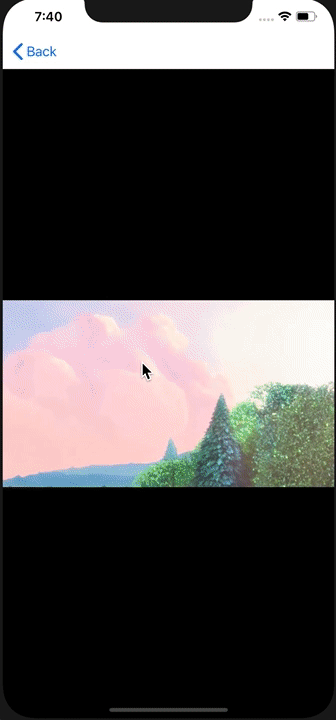Fun with crossplatform gestures and 360 videos
Touch management is handled quite differently on Android and iOS. Xamarin.Forms offers a nicely designed abstraction, inspired from the iOS APIs, which works across Android, iOS and UWP.
Seek and volume
Gestures can be useful to provide effective UX for seeking on videos and changing volume. Let’s see how we can implement exactly that.
We need a view that receives touch and we will display information on which actions it takes depending on the gestures.
<ContentPage.Content>
<Grid>
<Grid.GestureRecognizers>
<PanGestureRecognizer PanUpdated="PanUpdated"/>
</Grid.GestureRecognizers>
<AbsoluteLayout HorizontalOptions="FillAndExpand" VerticalOptions="FillAndExpand">
<vlc:VideoView x:Name="videoView" MediaPlayer="{Binding MediaPlayer}"
AbsoluteLayout.LayoutBounds="0,0,1,1"
AbsoluteLayout.LayoutFlags="All"
InputTransparent="True"/>
<Label Text="{Binding Message}"
AbsoluteLayout.LayoutBounds=".5,1,1,.1"
AbsoluteLayout.LayoutFlags="All"
FontSize="20"
LineBreakMode="WordWrap"
TextColor="White" />
</AbsoluteLayout>
</Grid>
</ContentPage.Content>
The PanGestureRecognizer is what we need.
The pan gesture is used for detecting the movement of fingers around the screen and applying that movement to content.
Additionally, I’ve put the usual VideoView in a crossplatform AbsoluteLayout to be able to position text on it as I want. That’s what the Label is for.
On the C# side, the interesting bit is how the PanUpdated event is handled.
internal void OnGesture(PanUpdatedEventArgs e)
{
switch (e.StatusType)
{
case GestureStatus.Running:
if (e.TotalX < 0 && Math.Abs(e.TotalX) > Math.Abs(e.TotalY))
{
var timeDiff = Convert.ToInt64(e.TotalX * 1000);
_finalTime = MediaPlayer.Time + timeDiff;
if (WillOverflow)
break;
Message = FormatSeekingMessage(timeDiff, _finalTime, Direction.Left);
_timeChanged = true;
}
else if (e.TotalX > 0 && Math.Abs(e.TotalX) > Math.Abs(e.TotalY))
{
var timeDiff = Convert.ToInt64(e.TotalX * 1000);
_finalTime = MediaPlayer.Time + timeDiff;
if (WillOverflow)
break;
Message = FormatSeekingMessage(timeDiff, _finalTime, Direction.Right);
_timeChanged = true;
}
else if (e.TotalY < 0 && Math.Abs(e.TotalY) > Math.Abs(e.TotalX))
{
var volume = (int)(MediaPlayer.Volume + e.TotalY * -1);
_finalVolume = VolumeRangeCheck(volume);
Message = FormatVolumeMessage(_finalVolume, Direction.Top);
_volumeChanged = true;
}
else if (e.TotalY > 0 && e.TotalY > Math.Abs(e.TotalX))
{
var volume = (int)(MediaPlayer.Volume + e.TotalY * -1);
_finalVolume = VolumeRangeCheck(volume);
Message = FormatVolumeMessage(_finalVolume, Direction.Bottom);
_volumeChanged = true;
}
break;
case GestureStatus.Started:
case GestureStatus.Canceled:
Message = string.Empty;
break;
case GestureStatus.Completed:
if (_timeChanged)
MediaPlayer.Time = _finalTime;
if (_volumeChanged && MediaPlayer.Volume != _finalVolume)
MediaPlayer.Volume = _finalVolume;
Message = string.Empty;
_timeChanged = false;
_volumeChanged = false;
break;
}
}
- The gesture has 4 states, we mostly do something during the Running and Completed ones.
- First we determine if the user is performing an horizontal swipe or a vertical one. The horizontal swipe will change the video position while the vertical one will be used to change the volume level.
- Either way, we compute and store a new value from the existing position/volume values and update the message on screen (
Messageis data-binded). - When the user is lifting its finger, the event is raised with the
Completedstatus and we apply the saved values to the LibVLCSharpMediaPlayer.

This code works on both Android and iOS.
360 videos
That very same logic can used to navigate 360 videos and change viewpoints, in a crossplatform way as well, albeit a few more considerations.
You need to check if the video being played is actually a 360 video. If it is, then the seeking/volume gestures should be disabled.
bool Is360Video => _media.Tracks[0].Data.Video.Projection == VideoProjection.Equirectangular;
You need to be aware of the screen dimensions for 360 navigation calculations.
protected override void OnSizeAllocated(double width, double height)
{
base.OnSizeAllocated(width, height);
ScreenWidth = width;
ScreenHeight = height;
}
Now, you are ready to handle the touch events. Here is a basic example code.
void PanUpdated(object sender, PanUpdatedEventArgs e)
{
switch (e.StatusType)
{
case GestureStatus.Running:
if (ScreenWidth > 0 && ScreenHeight > 0)
{
double range = Math.Max(ScreenWidth, ScreenHeight);
float yaw = (float)(Fov * -e.TotalX / range);// up/down
float pitch = (float)(Fov * -e.TotalY / range);// left/right
MediaPlayer.UpdateViewpoint(Yaw + yaw, Pitch + pitch, Roll, Fov);
}
break;
case GestureStatus.Started:
case GestureStatus.Canceled:
break;
case GestureStatus.Completed:
Fov = MediaPlayer.Viewpoint.Fov;
Pitch = MediaPlayer.Viewpoint.Pitch;
Roll = MediaPlayer.Viewpoint.Roll;
Yaw = MediaPlayer.Viewpoint.Yaw;
break;
}
}
Below is a demonstration of the 360 capability in the VLC Android application. Note that the sample code linked below also includes a screen with 360 gestures support with LibVLCSharp.
VLC 3.0 playing 8K 48fps 360 video on Android Galaxy S8 from VideoLAN on Vimeo.
This sample is available on the VideoLAN GitLab.
